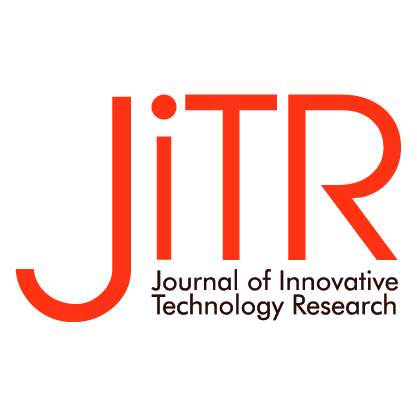การประยุกต์ใช้กำลังคลื่นส่งผ่านย่านความถี่เอ็กซ์เพื่อตรวจสอบการปลอมปนของน้ำผึ้งโดยไม่สัมผัส
คำสำคัญ:
น้ำผึ้ง, คุณสมบัติไดอิเล็กตริก, สายอากาศไมโครสตริป, การส่งผ่านคลื่นความถี่ไมโครเวฟบทคัดย่อ
บทความนี้นำเสนอการตรวจสอบน้ำผึ้งปลอมปนโดยใช้กำลังคลื่นแม่เหล็กไฟฟ้าส่งผ่านที่ความถี่ 10.525 กิกะเฮิรตซ์ ด้วยสายอากาศไมโครสตริป 2 ตัว แบ่งออกเป็นภาคส่งและภาครับ ทำงานร่วมกับเครื่องวิเคราะห์โครงข่าย เริ่มจากการหาความถี่ที่เหมาะสมด้วยการวัดคุณสมบัติไดอิเล็กตริกของน้ำผึ้งในช่วงความถี่ 0.2 ถึง 18 กิกะเฮิรตซ์ นำค่าที่ได้มาจำลองการตรวจวัดน้ำผึ้งด้วยโปรแกรมทางด้านแม่เหล็กไฟฟ้า โดยกำหนดเงื่อนไขน้ำผึ้งที่มีการปลอมปนด้วยน้ำตั้งแต่ร้อยละ 10 20 ถึง 70 ได้ค่ากำลังงานการส่งผ่าน |S21| จากการจำลองอยู่ที่ -33.02 -35.26 ถึง
-48.73 เดซิเบล กำลังงานการส่งผ่านตอบสนองอย่างชัดเจนต่อการปลอมปนของน้ำผึ้ง จากนั้นสร้างสายอากาศไมโครสตริปด้วยแผ่นวงจรพิมพ์ FR-4 แล้วทดสอบระบบตรวจสอบน้ำผึ้งปลอมด้วยสายอากาศต้นแบบ สายอากาศส่งต่อเข้ากับพอร์ตที่ 1 ของเครื่องวิเคราะห์โครงข่ายแบบเวกเตอร์และสายอากาศรับต่อเข้ากับพอร์ตที่ 2 ตรวจวัดน้ำผึ้งปลอมปนที่มีปริมาณ 200 มิลลิลิตร ทั้งหมด 7 ระดับ ค่า |S21| ที่ระดับการปลอมปนร้อยละ 10 ค่าที่ได้อยู่ที่ -31.91 เดซิเบล เมื่อเพิ่มขึ้นเป็นร้อยละ 20 อยู่ที่ -33.37 เดซิเบล และค่า |S21| ลดลงอย่างต่อเนื่องเมื่อการปลอมปนเพิ่มขึ้นเป็นร้อยละ 30 40 ถึง 70 ค่า |S21| อยู่ที่ -38.9 -43.1 ถึง –58.3 เดซิเบล ตามลำดับ กำลังงานการส่งผ่าน |S21| ที่เปลี่ยนแปลงอย่างชัดเจนต่อระดับการปลอมปนของน้ำผึ้ง แสดงให้เห็นถึงประสิทธิภาพในการตรวจสอบน้ำผึ้งปลอมจากการส่งผ่านกำลังงานความถี่ด้วยสายอากาศไมโครสตริป
เอกสารอ้างอิง
H. T. L. Nguyen, N. Panyoyai, S. Kasapis, E. Pang, and N. Mantri, “Honey and its role in relieving multiple facets of atherosclerosis,” Nutrients, vol. 11, no. 67, pp. 1-22, 2019.
A. Maric, P. Jovanov, M. Sakac, A. Novakovic, M. Hadnađev, L. Pezo, A. Mandic, N. Milicevic, A. Đurovic´and S. Gadˇzuric´, “A comprehensive study of parameters correlated with honey health benefits,” Royal Society Chemistry Advance, vol. 11, pp. 12434–12441, 2021.
Y. Ranneh, A. M. Akim, H. A. Hamid, H. Khazaai, A. Fadel, Z. A. Zakaria, M. Albujja and M. F. A. Bakar, “Honey and its nutritional and antiinflammatory value,” BMC Complementary Medicine and Therapies, vol. 21, no. 30, pp.1-17, 2021.
S. Bhat, A. Kudva, V. Boloor, and S. Rs, “Honey-a boon to oral health: a review,” International Journal of Research and Analytical Reviews (IJRAR), vol. 6, no. 2, pp. 847-852, 2019.
Office of the Secretary, Department of Agriculture Extension. (2020, June 1). DAE analyze the quality of honey and develop processed products to increase competitive potential and prepare to enter the online market [Online]. Available: https://secreta. doae.go.th/?p=5305, 18 Dec 2023.
A. Naila, S. H. Flint, A. Z. Sulaiman, A. Ajit, and Z. Weeds, “Classical and novel approaches to the analysis of honey and detection of adulterants,” Food Control, vol. 90, pp. 152-165, 2018.
Thai Health Promotion Foundation. (2017, June 20) Major arrest of fraud honey mixed with syrup and glucose syrup which has been sold for many years [Online]. Available: http://www.thaihealthconsumer.org.
E. Baglio, “The industry of honey. An introduction,” Chemistry and Technology of Honey Production, SpringerLink, pp. 7-8, 2018.
D. S. Hage, “Contemporary practice in clinical chemistry” Fourth Edition, Lincoln, University of Nebraka, 2019, pp. 135-157.
A. A. Bakar, M. A. N. Rodzali, R Radzali, A. Idris, and A. R. Razali,”Dielectric properties assessment of honey by using non-destructive dielectric spectroscopy,” International Journal of Electrical and Computer Engineering (IJECE), vol. 12, no. 1, pp. 189-200, 2022.
E. M Cheng, K. Y. Lee, S. F. Khor, N. F. Mohd Nasir, C. W. S. R. Mohamad, N. A. Abdul Aziz, E. Z. Mohd Tarmizi, and S. A. Baharuddin, “Microwave dielectric and reflection analysis on Pure and Adulterated Trigona Honey and Honey Gold,” Radioengineering, vol. 31, no. 3, pp. 281-294, 2022.
K. Pentos, and D. Luczycka, “Dielectric properties of honey: the potential sability for quality assessment,” European Food Research and Technology, vol. 244, no. 5, pp. 874-880, 2018.
A. Nuan-on, N. Angkawisittapan, S. Photong, and A. Siritharathivat, “Detection of water adulteration in honey using coaxial capacitor sensor,” SWU Engineering journal, vol. 10, no. 2, pp. 9-18, 2015.
Z. Li, A. Haigh, C. Soutis, A. Gibson, and R. Sloan, “Evaluation of water content in honey using microwave transmission,” Journal of Food Engineering, vol. 125, pp. 113-125, 2017.
P. Leekul, and P. Chaisaeng, “Non-contact moisture content monitoring of growing media in bonsai pot by using radio wave frequency at 2.5 GHz,” The Journal of Industrial Technology Suan Sunandha Rajabhat University, vol.7, no. 1, pp. 21-30, 2019.
P. Chaisaeng, T. Limpiti, and P. Leekul, “Intelligent sensor system with transmission coefficient in X-band frequency for determining sugar content,” Progress in Electromagnetics Research C, vol. 135, pp. 157–172, 2023.
P. Kumar, P. Coronel, J. Simunovic, V. D. Truong, and K. P. Sandeep, “Measurement of dielectric properties of pumpable food materials under static and continuous flow conditions,” Journal of Food Science, vol. 72, no. 4, pp. 177-183, 2007.
P. Phonkitiphan, and P. Silapan, “Design and analysis the microstrip antenna fo 2.4 GHz using graphene material,” Master of Engineering (Electrical and Computer Engineering), Silpakorn University, Bangkok, 2019.
C. A. Balanis, “Antenna theory analysis and design,” John Wiley & Sons: Canada, 2006.
P. Chaisaeng, P. Leekul, P. Wongcharoen, and K. Kunsook, “Permittivity measurement of syrup in wideband frequency for simulation of sugar content determination by artificial neural network,” Journal of Industrial Technology I-Tech, vol. 15, no. 2, pp. 132-142, 2020.
P. Thanasetwatthana, P. Chaisaeng, and P. Leekul, “Development of regression process for storage time of natural rubber latex classification using microwave frequencies,” The Journal of Industrial Technology Suan Sunandha Rajabhat University, vol. 10, no. 1, pp. 12-22, 2022

ดาวน์โหลด
เผยแพร่แล้ว
รูปแบบการอ้างอิง
ฉบับ
ประเภทบทความ
สัญญาอนุญาต
ลิขสิทธิ์ (c) 2024 สถาบันวิจัยและพัฒนา มหาวิทยาลัยเทคโนโลยีราชมงคลล้านนา

อนุญาตภายใต้เงื่อนไข Creative Commons Attribution-NonCommercial-NoDerivatives 4.0 International License.
กองบรรณาธิการขอสงวนสิทธิ์ในการปรับปรุงแก้ไขตัวอักษรและค่าสะกดต่าง ๆ ที่ไม่ถูกต้อง และต้นฉบับที่ได้รับการตีพิมพ์ในวารสารเทคโนโลยีและนวัตกรรม ถือเป็นกรรมสิทธิ์ของสถาบันวิจัยและพัฒนา มหาวิทยาลัยเทคโนโลยีราชมงคลล้านนา และผลการพิจารณาคัดเลือกบทความตีพิมพ์ในวารสารให้ถือเป็นมติของกองบรรณาธิการเป็นที่สิ้นสุด




